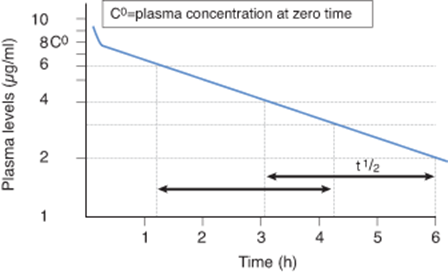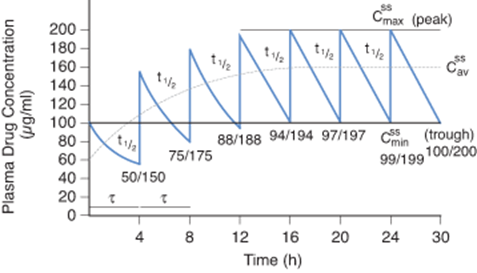If you’re preparing for the United States Medical Licensing Examination® (USMLE®) Step 1 exam, you might want to know which questions are most often missed by test-prep takers. Check out this example from Kaplan Medical, and read an expert explanation of the answer. Also check out all posts in this series.
This month’s stumper
During an investigational study, the pharmacokinetics of a newly synthesized drug are studied in healthy volunteers. The volume of distribution and clearance determined in the first volunteer are 40 L and 2.0 L/hour, respectively.
Which of the following is the most likely half-life of the drug in this volunteer?
A. 2 hours.
B. 6 hours.
C. 14 hours.
D. 20 hours.
E. 28 hours.
The correct answer is C.
Kaplan Medical explains why
The half-life (t1/2) of a drug is the time required for the amount of drug in the body or blood to fall by 50%. It is only applicable to drugs that exhibit first-order kinetics, in which a constant fraction of drug is eliminated per unit time as shown below. In zero-order kinetics, a constant amount of drug is eliminated per unit time.
T1/2 can be determined if the clearance (Cl) and volume of distribution (Vd) is known. Cl is the ratio of the rate of elimination of a drug to the concentration in the plasma (rate of elimination/plasma drug concentration). The Vd is the ratio of the amount of drug in the body to the drug concentration in the plasma (amount of drug in body/plasma drug concentration).
The half-life of a drug can be determined using the following equation:
t1/2 = (0.7 times Vd) / Cl
Therefore, t1/2 = (0.7 times 40L) / 2.0 L/hour, and t1/2 = 14 hours.
Note: 0.7 is a commonly used log approximation, but not the actual value. Another commonly used approximation is 0.693 for -ln(0.5) = 0.69315.
The half-life determines the rate at which a drug concentration rises during a constant infusion and also the rate at which the concentration falls after drug administration is stopped. It is commonly accepted that it takes four to five half-lives to reach steady state, as shown in the figure to the right.
Tips to remember
- The half-life (t1/2) is the time it takes for the plasma concentration of a drug or the amount of drug in the body to be reduced by 50%.
- The half-life of a drug can be determined using the following equation: t1/2 = (0.7 x Vd) / Cl, where Vd is volume of distribution and Cl is clearance.
For more prep questions on USMLE Steps 1, 2 and 3, view other posts in this series.
The AMA and Kaplan have teamed up to support you in reaching your goal of passing the USMLE® or COMLEX-USA®. If you're looking for additional resources, Kaplan provides free access to tools for pre-clinical studies, including Kaplan’s Lecture Notes series, Integrated Vignettes, Shelf Prep and more.





